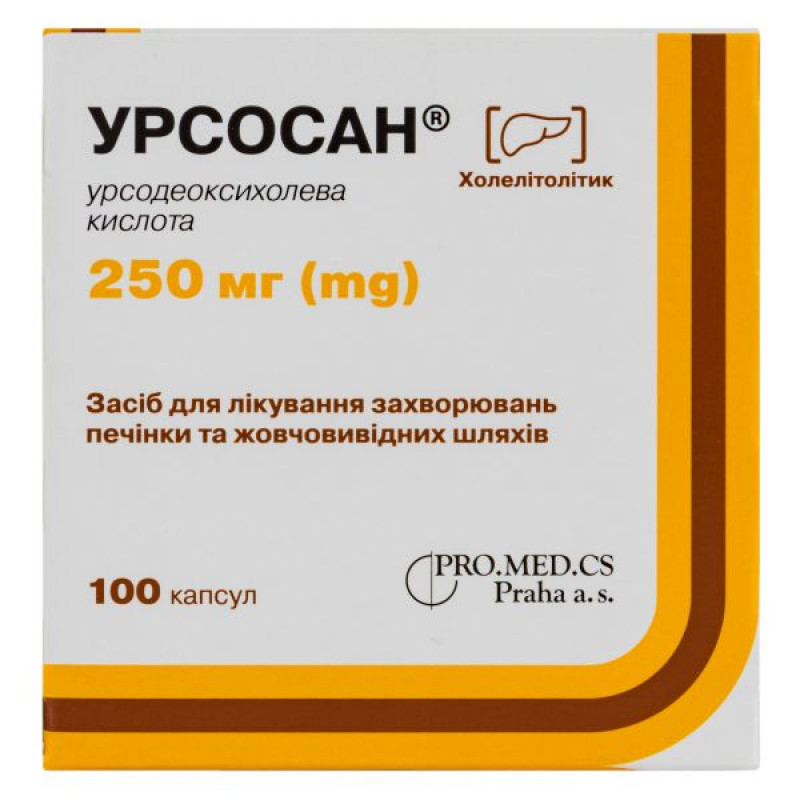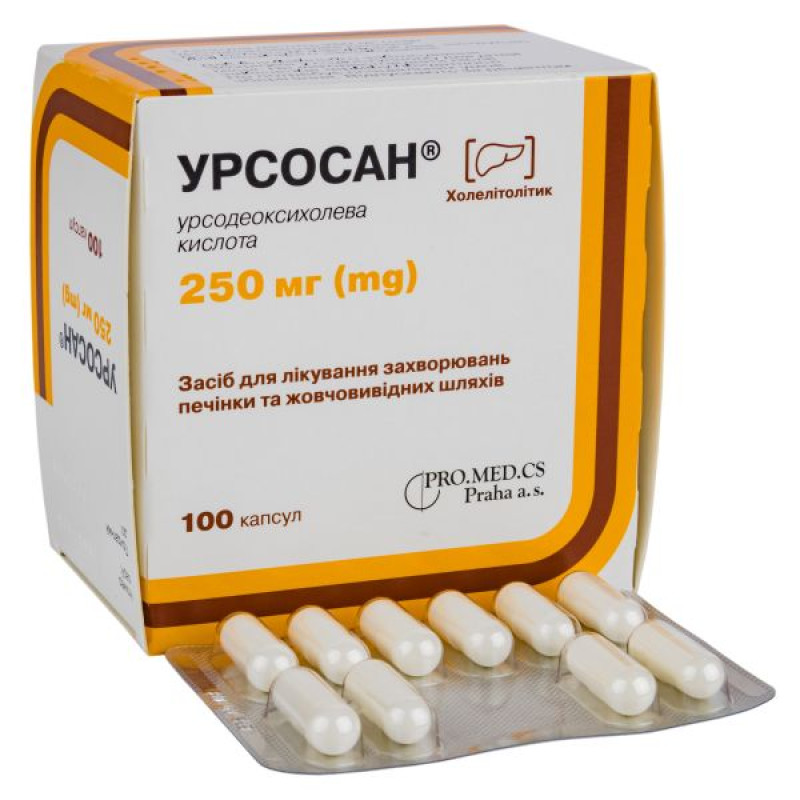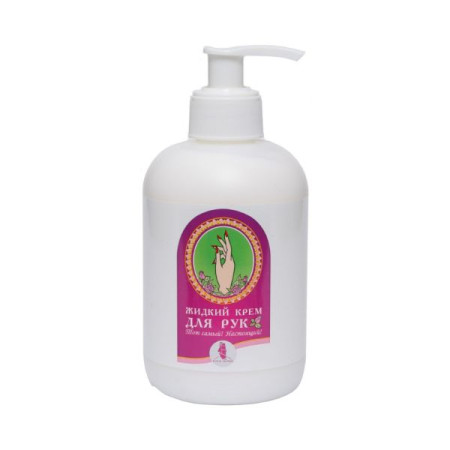Ursosan capsules 250 mg No. 100

Instructions for Ursosan capsules 250 mg No. 100
Composition
active ingredient: ursodeoxycholic acid;
1 capsule contains 250 mg of ursodeoxycholic acid;
excipients: corn starch, pregelatinized starch, colloidal anhydrous silicon dioxide, magnesium stearate;
capsule composition: gelatin, titanium dioxide (E 171).
Dosage form
Capsules.
Main physicochemical properties: white hard gelatin capsules size No. 0, containing white or almost white powder; or white or almost white powder with lumps of mass; or white or almost white powder, compressed into a column that disintegrates when pressed.
Pharmacotherapeutic group
Drugs used to treat the liver and biliary tract. Drugs used in case of biliary pathology.
ATX code A05A A02.
Drugs used in cases of liver disease are lipotropic substances.
ATX code A05B.
Pharmacological properties
Pharmacodynamics
A small amount of ursodeoxycholic acid has been found in human bile.
After oral administration, it reduces the cholesterol saturation of bile by inhibiting its absorption in the intestine and reducing cholesterol secretion into the bile. Perhaps due to the dispersion of cholesterol and the formation of liquid crystals, the gradual dissolution of gallstones occurs.
It is believed that the effect of ursodeoxycholic acid in liver diseases and cholestasis is due to the relative replacement of lipophilic, detergent-like toxic bile acids with hydrophilic cytoprotective non-toxic ursodeoxycholic acid, improvement of the secretory capacity of hepatocytes, and immunoregulatory processes.
Use in children
Cystic fibrosis
There is information available from clinical reports regarding the long-term use of ursodeoxycholic acid (up to 10 years) in the treatment of children with hepatobiliary disorders associated with cystic fibrosis. There is evidence that the use of ursodeoxycholic acid can reduce proliferation in the bile ducts, stop the progression of histological changes and even eliminate hepatobiliary changes if therapy is started in the early stages of cystic fibrosis. For best effectiveness, treatment with ursodeoxycholic acid should be started immediately after the diagnosis of cystic fibrosis is clarified.
Pharmacokinetics
Ursodeoxycholic acid is rapidly absorbed from the small intestine and upper ileum by passive diffusion and from the terminal ileum by active transport. The extent of absorption is 60-80%. After absorption, the bile acid undergoes almost complete conjugation in the liver with the amino acids glycine and taurine and is then excreted in the bile. The first-pass clearance through the liver is up to 60%. Depending on the daily dose and the underlying liver disorder or condition, the more hydrophilic ursodeoxycholic acid accumulates in the bile. At the same time, there is a relative decrease in other more lipophilic bile acids.
Under the influence of intestinal bacteria, partial degradation occurs to 7-ketolithocholic and lithocholic acids. Lithocholic acid is hepatotoxic and causes damage to the liver parenchyma in some animal species. In humans, only a small amount is absorbed, which is sulfated in the liver and thus detoxified before being excreted in the bile and, finally, in the feces.
The biological half-life of ursodeoxycholic acid is 3.5-5.8 days.
Indication
For the dissolution of radiopaque cholesterol gallstones up to 15 mm in diameter in patients with a functioning gallbladder, despite the presence of gallstone(s).
For the treatment of biliary reflux gastritis.
For the symptomatic treatment of primary biliary cirrhosis (PBC) in the absence of decompensated liver cirrhosis.
For the treatment of hepatobiliary disorders in cystic fibrosis in children aged 6 to 18 years.
Contraindication
Hypersensitivity to any of the ingredients of the drug. Acute inflammation of the gallbladder or bile ducts. Obstruction of the bile ducts (obstruction of the common bile duct or cystic duct). Frequent episodes of hepatic colic. Radiopaque calcified gallstones. Violation of gallbladder contractility. Late stages of primary biliary cirrhosis due to insufficient therapeutic effect. Use in children: unsuccessful outcome of portoenterostomy or lack of adequate bile outflow in children with biliary atresia.
Interaction with other medicinal products and other types of interactions
Ursosan 250 mg capsules may increase the absorption of cyclosporine from the intestine. In patients taking cyclosporine, the doctor should check the concentration of this substance in the blood and, if necessary, adjust the dosage of cyclosporine.
In some cases, Ursosan 250 mg capsules may reduce the absorption of ciprofloxacin.
In a clinical study in healthy volunteers, concomitant administration of ursodeoxycholic acid (500 mg/day) and rosuvastatin (20 mg/day) resulted in a slight increase in rosuvastatin plasma concentrations. The clinical significance of this interaction, as well as its significance for other statins, is unknown.
Ursodeoxycholic acid has been shown to reduce the maximum plasma concentration (Cmax) and area under the curve (AUC) for the calcium antagonist nitrendipine in healthy volunteers.
Careful monitoring of the outcome of concomitant use of nifedipine and ursodeoxycholic acid is recommended. An increase in the dose of nifedipine may be necessary.
In addition, a weakening of the therapeutic effect of dapsone has been reported.
These data, as well as in vitro data, suggest that ursodeoxycholic acid has the potential to induce cytochrome P450 3A enzymes. However, in a well-designed interaction study with budesonide, a proven substrate of cytochrome P450 3A, no such effect was observed.
Extragenic hormones, as well as drugs to reduce blood cholesterol levels, can increase the secretion of cholesterol by the liver, and thus contribute to the formation of gallstones, which is the opposite effect of ursodeoxycholic acid, which is used to dissolve them.
Application features
Ursosan 250 mg capsules should be taken under the supervision of a doctor.
Liver function tests (AST, ALT and GGT) should be monitored every 4 weeks during the first 3 months of treatment and every 3 months thereafter. This allows for the assessment of the response or non-response in PBC patients and the early detection of potential liver dysfunction, particularly in patients with advanced PBC.
Uses for dissolving cholesterol gallstones
In order to assess the progress of treatment, as well as for timely detection of any signs of calcification of stones depending on the size of the stones, visualization of the gallbladder (oral cholecystography) with examination of the obscurations in the patient's standing and supine positions (under ultrasound guidance) should be performed 6-10 months after the start of treatment.
Ursosan 250 mg capsules should not be used if the gallbladder cannot be visualized on X-rays or in case of calcification of stones, impaired gallbladder contractility or frequent hepatic colic.
Women taking Ursosan 250 mg capsules to dissolve gallstones should use an effective non-hormonal method of contraception, as hormonal contraceptives may increase the formation of gallstones.
Treatment of patients with advanced stage PBC
Decompensated liver cirrhosis has been reported extremely rarely, which may partially regress after discontinuation of therapy.
In patients with PBC, very rarely, symptoms may worsen at the beginning of treatment, for example, itching may increase. In such cases, the dose of Ursosan 250 mg capsules should be reduced to one capsule per day; then the dose should be gradually increased as described in the section "Method of administration and dosage".
If diarrhea occurs, the dosage should be reduced; if diarrhea persists, treatment should be discontinued.
Ability to influence reaction speed when driving vehicles or other mechanisms
No effect on the ability to drive or use other mechanisms was observed.
Use during pregnancy or breastfeeding
Animal studies have not shown any effect of ursodeoxycholic acid on fertility. There are no data on the effect on fertility in humans.
There are insufficient data on the use of ursodeoxycholic acid in pregnant women. Animal studies have shown reproductive toxicity in early pregnancy. Ursosan 250 mg capsules should not be used during pregnancy unless clearly necessary. Women of childbearing potential should only take the drug if they are using reliable contraception.
It is recommended to use non-hormonal contraceptives or oral contraceptives with a low estrogen content. Patients receiving Ursosan 250 mg capsules for the dissolution of gallstones should use effective non-hormonal contraceptives, since hormonal oral contraceptives may increase the risk of gallstone formation. Pregnancy should be excluded before starting treatment.
According to several recorded cases of use of the drug in breastfeeding women, the content of ursodeoxycholic acid in milk was extremely low, so no adverse effects should be expected in children receiving such milk.
Method of administration and doses
To dissolve cholesterol gallstones
Approximately 10 mg ursodeoxycholic acid/kg body weight (see Table 1)
| Body weight | Number of capsules |
| up to 60 kg | 2 |
| 61-80 kg | 3 |
| 81-100 kg | 4 |
| over 100 kg | 5 |
The capsules should be swallowed whole with water, once a day in the evening before bedtime.
Capsules should be taken regularly.
The time required for gallstones to dissolve is usually 6-24 months. If a reduction in gallstone size is not observed after 12 months of treatment, therapy should not be continued.
The success of the treatment should be checked every 6 months by ultrasound or X-ray. Additional tests should be performed to check whether calcification of the stones has occurred over time. If this occurs, treatment should be discontinued.
For the treatment of biliary reflux gastritis
1 capsule of Ursosan 250 mg once a day with some liquid in the evening before bedtime.
Usually, for the treatment of gastritis with bile reflux, Ursosan 250 mg capsules should be taken for 10-14 days. The duration of use depends on the patient's condition. The doctor should decide on the duration of treatment in each case individually.
For the symptomatic treatment of primary biliary cirrhosis (PBC)
The daily dose depends on body weight and varies from 3 to 7 capsules (14 ± 2 mg ursodeoxycholic acid/kg body weight).
During the first 3 months of treatment, Ursosan 250 mg capsules should be taken throughout the day, dividing the daily dose into 3 doses. If liver function indicators improve, the daily dose can be taken once a day in the evening.
| Body weight (kg) | Daily dose (mg/kg body weight) | Number of capsules | |||
| first 3 months | in the future | ||||
| morning | day | evening | evening (once a day) | ||
| from 47 to 62 kg | 12-16 | 1 | 1 | 1 | 3 |
| from 63 to 78 kg | 13-16 | 1 | 1 | 2 | 4 |
| from 79 to 93 kg | 13-16 | 1 | 2 | 2 | 5 |
| from 94 to 109 kg | 14-16 | 2 | 2 | 2 | 6 |
| over 110 kg | 2 | 2 | 3 | 7 |
The capsules should be swallowed whole with liquid. It is necessary to take the capsules regularly.
The use of Ursosan 250 mg capsules for the treatment of primary biliary cirrhosis may be unlimited in time.
In patients with primary biliary cirrhosis, a rare worsening of clinical symptoms, for example, pruritus, may occur at the beginning of treatment. In this case, therapy should be continued by taking 1 capsule of Ursosan 250 mg per day, then gradually increasing the dose (increasing the daily dose by 1 capsule every week) until the prescribed dosage regimen is reached.
Use in children
For children with cystic fibrosis aged 6 to 18 years, the dosage is 20 mg/kg/day and is divided into 2-3 doses, with a subsequent increase in the dose to 30 mg/kg/day if necessary.
| Body weight (kg) | Daily dose (mg/kg) | Ursosan, capsules, 250 mg each | ||
| Morning | Day | Evening | ||
| 20–29 | 17-25 | 1 | 1 | |
| 30–39 | 19-25 | 1 | 1 | 1 |
| 40–49 | 20-25 | 1 | 1 | 2 |
| 50–59 | 21-25 | 1 | 2 | 2 |
| 60–69 | 22-25 | 2 | 2 | 2 |
| 70–79 | 22-25 | 2 | 2 | 3 |
| 80–89 | 22-25 | 2 | 3 | 3 |
| 90–99 | 23-25 | 3 | 3 | 3 |
| 100–109 | 23-25 | 3 | 3 | 4 |
| >110 | 3 | 4 | 4 |
Children
For the dissolution of cholesterol gallstones, treatment of biliary reflux gastritis, and symptomatic treatment of PBC
There are no fundamental age restrictions for the use of ursodeoxycholic acid in children; if the child weighs less than 47 kg and/or if the child has difficulty swallowing, it is recommended to use ursodeoxycholic acid in a different dosage form.
For the treatment of hepatobiliary disorders in cystic fibrosis
Apply to children aged 6 to 18 years.
Overdose
In cases of overdose, diarrhea may occur. In general, other symptoms of overdose are unlikely, since the absorption of ursodeoxycholic acid decreases with increasing dose and therefore most of it is excreted in the feces.
If diarrhea occurs, the dose should be reduced, and if diarrhea is persistent, therapy should be discontinued.
No specific measures are required. The consequences of diarrhea should be treated symptomatically with restoration of fluid and electrolyte balance.
Additional information regarding special patient groups
Long-term therapy with high doses of ursodeoxycholic acid (28-30 mg/kg/day) in patients with primary sclerosing cholangitis (off-label use) was associated with a higher incidence of serious adverse events.
Adverse reactions
The assessment of the frequency of adverse reactions is based on the following data:
Very common: >1/10.
Common: >1/100 and <1/10.
Uncommon: >1/1000 and <1/100.
Rare: >1/10,000 and <1/1,000.
Very rare: <1/10,000, including isolated cases.
In clinical trials, pasty stools or diarrhea were commonly reported during treatment with ursodeoxycholic acid.
Very rarely, severe abdominal pain localized in the right hypochondrium was noted during the treatment of primary biliary cirrhosis.
Liver and gallbladder
Very rarely, calcification of gallstones is possible during treatment with ursodeoxycholic acid.
During the treatment of advanced stages of primary biliary cirrhosis, decompensation of liver cirrhosis is very rarely observed, which partially regressed after discontinuation of treatment.
Hypersensitivity reactions
Very rarely, allergic reactions are possible, including rash and urticaria.
Expiration date
4 years.
Storage conditions
In the original packaging, out of the reach of children, at a temperature not exceeding 25 °C.
Packaging
10 capsules in a blister; 10 blisters in a cardboard box.
Vacation category
According to the recipe.
Producer
PRO.MED.CS Praha a.s./PRO.MED.CS Prahа as
Location of the manufacturer and its business address
Telcska 377/1, Michle, Prague 4, 140 00, Czech Republic./Telсska 377/1, Michle, Praha 4, 140 00, Czech Republic.
There are no reviews for this product.
There are no reviews for this product, be the first to leave your review.
No questions about this product, be the first and ask your question.














